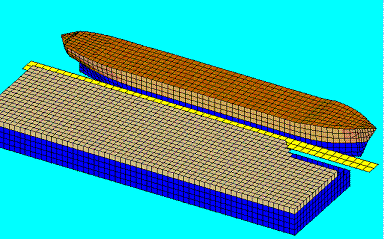This data record is used to define a "lid" for reduction of the standing wave that may occur in a moonpool or between two hydrodynamically interacting vessels. The lid has to be manually defined; there is no automatic generation facility as there is with the ILID data record.
The lid is modeled by horizontal diffracting elements that must be contained in a single specified group. Their effect is controlled by two parameters: a "damping factor" and a characteristic length. The elements should be at the water surface between the vessels and have their normals pointing upwards. They do not need to follow the vessel outline closely so a simple mesh should be adequate, as illustrated in the figure below.
VLID elements cannot form a structure on their own; they must be part of an existing structure.
2 5 7 11 16 21
- --- -- ---- ----- ----- -----------------------------
|X| | |VLID| | |(DAMP=???,GAP=???)
- --- -- ---- ----- ----- -----------------------------
| | | | |
| | | | |_(2)Mandatory parameters
| | | |
| | | |_(1)Group number
| | |
| | |_Compulsory Data Record Keyword (A4)
| |
| |_Optional User Identifier (A2)
|
|_Compulsory END on last data record in Data Category (A3)
(1) This is the group number that will be used for the lid elements. If there is more than one structure with a lid a different group must be used for each lid. If a group number is not specified a default value of 999 will be used.
(2) Lid Parameters
DAMP: damping factor for the lid, typically between 0.0 and 0.2; 0 will give no effect, 0.2 will result in heavy damping of surface elevation at the elements.
GAP: characteristic length for the lid. This will typically be the gap between two adjacent vessels or the smallest dimension of a moonpool. It is not used to define the size of the lid itself.

- --- -- ---- ----- ----- -----------------------------
|X| | |VLID| | 135| (DAMP=0.02,GAP=10.0)
- --- -- ---- ----- ----- -----------------------------


